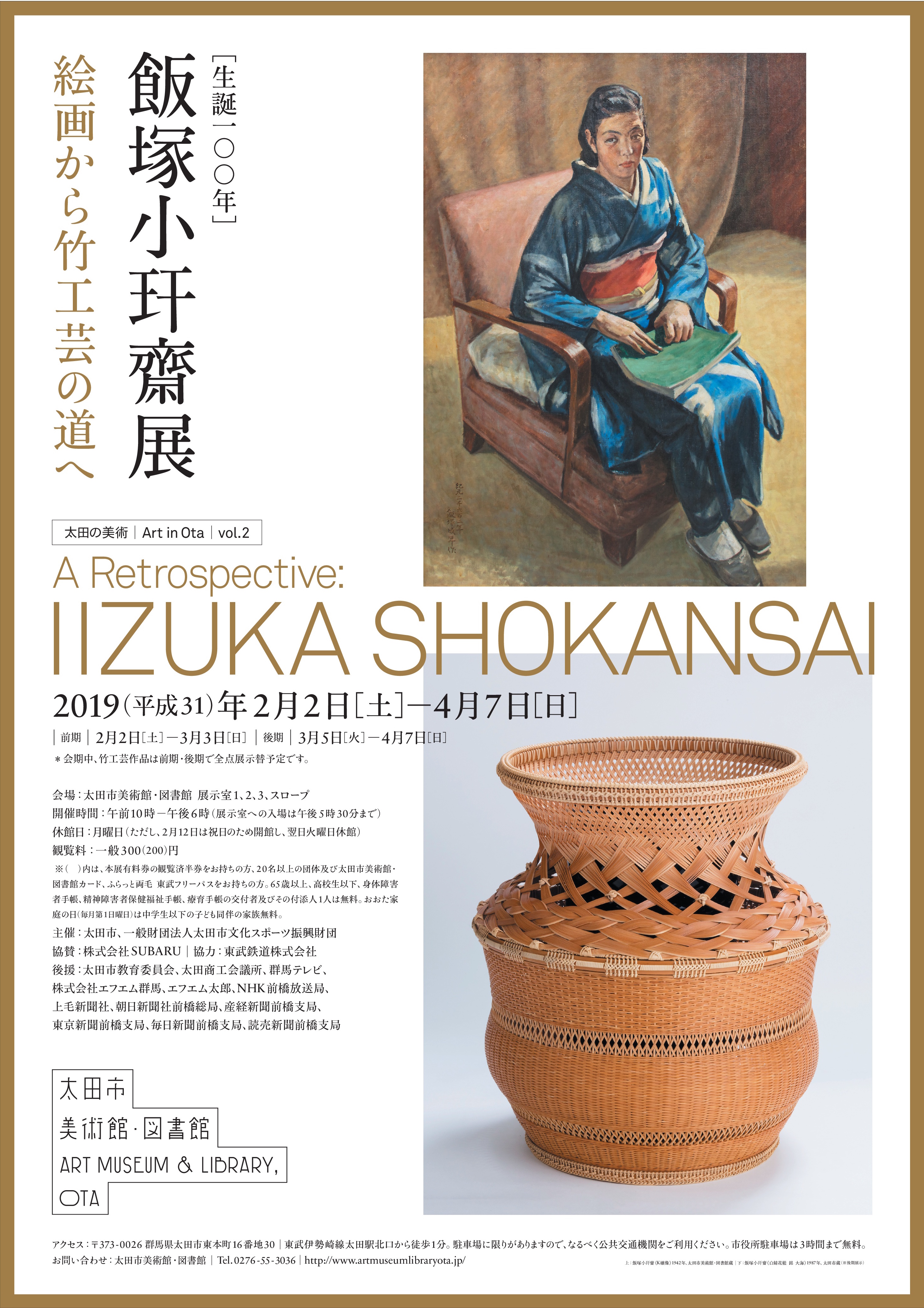Ota Art vol. 2 “100 years since the birth of Shokansai Iizuka – From painting to bamboo crafts”
From Feb. 2, 2019 (Sat) to Apr. 7, 2019 (Sun)

Information
Title: Ota Art vol. 2 “100 years since the of birth Shokansai Iizuka – From painting to bamboo crafts”
Venue: Art Museum & Library, Ota, Exhibition Rooms 1, 2, 3, and Slope
Period: Feb. 2, 2019 (Sat) – Apr. 7, 2019 (Sun)/ 56 days
Some of the exhibited works and documents will be changed during this period. Please contact us for details.
(First half: Feb 2-Mar 3; Second half: Mar 5-Apr 7)
Open: 10:00 am to 6:00 pm (Last admission to exhibition rooms is before 5:30 pm.)
Closed: Mondays (Open on February 11 national holiday, and closed the following Tuesday).
Organized by: Ota City, Ota City Culture and Sports Promotion Foundation
In partnership with: SUBARU
Supported by: Shiseido, Komoto Industries, Tochigi Prefectural Art Museum, Tokyo University of the Arts, Tobu Railway, Sakutaro Hagiwara Memorial- Water, nature and poetry town- Maebashi Bungakukan, Rokando
Sponsored by: Ota City Board of Education, Ota Chamber of Commerce and Industry, Gunma TV, FM Gunma, FM Taro, NHK Maebashi Station, Jomo News, Asahi News Maebashi, Sankei News Maebashi, Tokyo News Maebashi, Hikari Net Co., Ltd., Mainichi News Maebashi, Yomiuri News Maebashi
Admission fees: General 300 (200) yen
*Fees shown in( )are for groups of over 20 people, as well as Art Museum & Library, Ota ticket stub owners and Furatto Ryomo Tobu Free Pass holders.
Free access for people over 65, under 18, and holders of physical disability certificate, mental impairment welfare insurance certificate, rehabilitation certificate and for one assistant. Free access for families accompanying children under 15 on Ota Family Day (first Sunday of each month).
Overview
“I think that bamboo is the most beautiful in its natural state”- Shokansai Iizuka (1919-2004 / real name: Shigetoshi) is a bamboo craftsman who respected the raw material and aimed to express the unique beauty of bamboo. In 1982, he was recognized as a holder of Important Intangible Cultural Property “Bamboo crafts” (living national treasure). His refined works are based on the philosophy of “Utilitarian beauty”. Attracted by the rich natural environment of Mt. Kanayama covered in Japanese red pine, he moved to Ota City, Gunma Prefecture, in 1981 from Tokyo, and spent the rest of his life here working in his workshop. He developed the techniques learned from his father Rokansai by adding a modern sensibility, thus building the foundation of today’s bamboo crafts, and creating elegant and sophisticated works.
It is little known that Shokansai wanted, in fact, to be a painter when he was young. Born as the second son of the Iizuka’s, traditional bamboo craftsmen from generation to generation, he had known bamboo from an early age but entered the Tokyo School of Fine Arts Oil Painting Department (today’s Tokyo University of the Arts) to become a painter and studied under Takeji Fujishima. However, his elder brother Mikio, who had trained in the bamboo crafts with his father so he could continue the family business, passed away in 1943. After being demobilized, Shokansai gave up his dream of being a painter and entered the bamboo craft world under Rokansai’s guidance. His early works as a bamboo craftsman exhibited at The Japan Fine Arts Exhibition used bamboo as a material but also incorporated concrete and abstract expressions clearly influenced by his formation as a painter. However, working the bamboo day in and day out led him to create a different type of works, that did not require having an eye for painting. He began to pursue the “utilitarian beauty ” that is unique to bamboo objects originally meant to be used for daily activities.
This exhibition commemorates the 100th anniversary of Shokansai Iizuka birth. It features sketches from his junior high school days that already identify him as a prodigy, his graduation project from Tokyo School of Fine Arts, and bamboo artworks that illustrate evidence of painting expressions. Finally, the exhibition offers a glimpse of “utilitarian beauty” through a collection of about 30 bamboo works and documents. This is the story of Shokansai Iizuka, an artist who at first moved against his will from painting to bamboo craftworks, faced this new challenge and material, and continued to question the meaning of craft and beauty.
Exhibition composition and highlights
1. From the student days to the 1970s (Exhibition Room 1)
A display of Shokansai’s works from when he was striving to become a painter, from junior high school works to sketches and oil paintings done at Tokyo Art School, together with works by Takeji Fujishima, his tutor. Also displayed are works and documents created after the war when he was exploring pictorial expression and through to the period when he shifted to a focus on the material (1950s-1970s).
Major works on display: Sketches from his student days, Shokansai Iizuka’s graduation project (Miss K, 1942), bamboo craftworks from the 1950s to the 1970s, and paintings by Takeji Fujishima
2. Special Exhibition: Sakutaro Hagiwara “Bamboo” (Slope)
The poem “Bamboo” (Barking at the Moon, 1917) by Sakutaro Hagiwara (1886-1942), a poet from Gunma known as the father of modern Japanese poetry, is displayed on the wall of the Slope and visible from outside the building. It is our interpretation of the beauty of bamboo that became Shokansai Iizuka’s lifelong pursuit, from a different perspective than that of bamboo crafts.
Works displayed: Sakutaro Hagiwara, “Bamboo”
3. From the 1980s to the last year (Exhibition Room 2)
A display of Shokansai’s works that he created in pursuit of “utilitarian beauty” after setting up residence in Ota.
Major works on display: Bamboo craftworks from the 1980s to the 2000s
4. Shokansai Iizuka and Ota (Exhibition Room 3)
Photos of the house and workshop Shokansai Iizuka had in Kanayama-cho, Ota, and video materials that show him creating his works.
